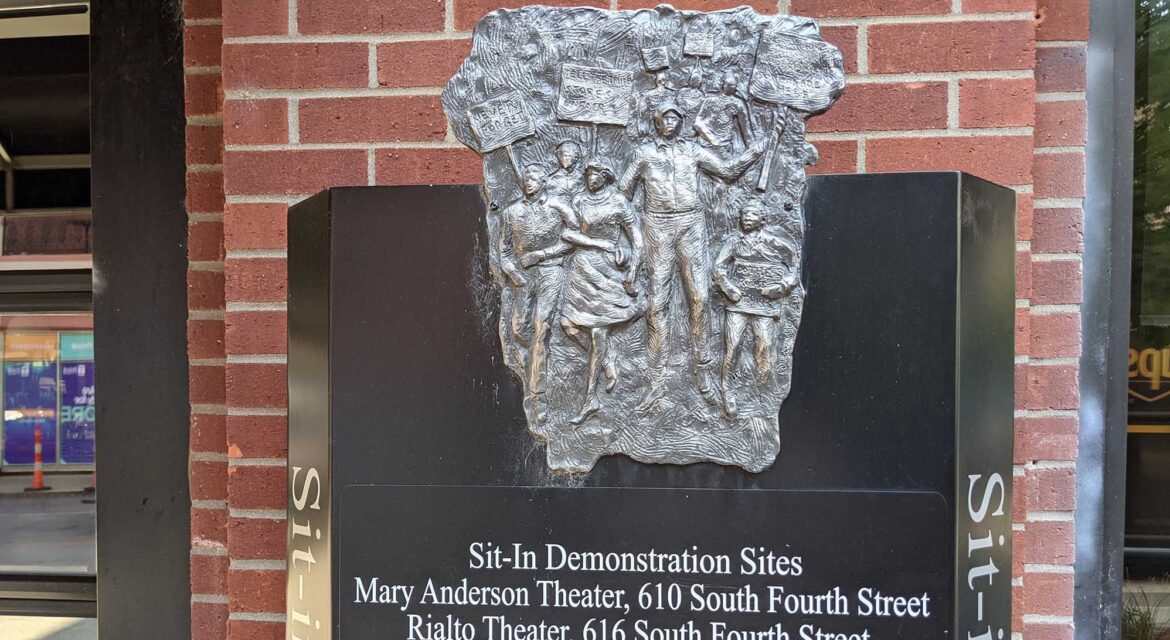 The Louisville Sit-in Demonstration Sites preserve the history that is associated with the Civil Rights Demonstrations that took place in the 1960s in Louisville, Kentucky. The legacy of those who participated in the demonstrations has been called out as part of 11 historic markers spread across tthe downtown area, enabling audiences to experience this history on multiple levels.
The Louisville Sit-in Demonstration Sites preserve the history that is associated with the Civil Rights Demonstrations that took place in the 1960s in Louisville, Kentucky. The legacy of those who participated in the demonstrations has been called out as part of 11 historic markers spread across tthe downtown area, enabling audiences to experience this history on multiple levels.

Preserving the Endeavor to End Racial Segregation
 A vision of J. Blaine Hudson, the idea behind the Demonstration Site markers was to preserve the history, heritage and contributions of African Americans to Louisville’s history. Those contributions were centered on the community’s push to end segregation practices that defined Louisville in the 1950s. These demonstrations began in 1956, but a full-scale assault on racial segregation in Louisville took shape in a much bigger way during the “Nothing New for Easter” boycott when local high school students staged non-violent demonstrations.
A vision of J. Blaine Hudson, the idea behind the Demonstration Site markers was to preserve the history, heritage and contributions of African Americans to Louisville’s history. Those contributions were centered on the community’s push to end segregation practices that defined Louisville in the 1950s. These demonstrations began in 1956, but a full-scale assault on racial segregation in Louisville took shape in a much bigger way during the “Nothing New for Easter” boycott when local high school students staged non-violent demonstrations.
As part of a movement to demand the passage of laws to end public racial segregation, students staged a sit-in at the lunch counter of Louisville’s largest department store, Stewart’s Dry Goods. It was one of the many protests and sit-ins that took place along Fourth Street, which was Louisville’s primary corridor of commerce and activity. It was not until the public accommodations ordinance was passed in 1963 that these demonstrations ended.
Designed by Ed Hamilton, each marker that is part of the Louisville Sit-in Demonstration Sites bears a logo depicting student protests to symbolize the civil rights movement in Louisville, the South and the nation in the 1960s. The icon adorns 11 distinct stops on the walking tour, with the Stewart’s Dry Goods marker being #3. Markers are located in places that vary from contemporary Walgreens stores to landmarks like the Brown Theater.
Although many of them look different than they did when these events took place, the effort to cultivate experiences that audiences can have with these locations has allowed the Louisville Sit-in Demonstration Sites to highlight what it can mean for audiences to be part of literal history. That expereince has and will continue to connect with people across the eras.

Preserving and Celebrating History
 Many of the businesses where civil rights demonstrations took place in the 1960s are gone, replaced by other storefronts or entirely new buildings. With so much around the area and community changing, the the Louisville Sit-in Demonstration Sites markers are permanent fixtures that preserve the history of the civil rights movement in a way that will resonate for audiences in the present and future.
Many of the businesses where civil rights demonstrations took place in the 1960s are gone, replaced by other storefronts or entirely new buildings. With so much around the area and community changing, the the Louisville Sit-in Demonstration Sites markers are permanent fixtures that preserve the history of the civil rights movement in a way that will resonate for audiences in the present and future.

